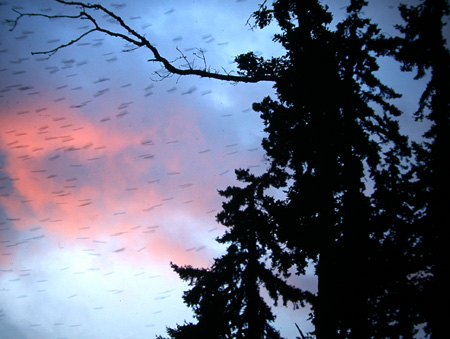Recovered from the Wayback Machine.
Webloggers may vary in their support of technologies such as comments and trackbacks and RSS, but two things most agree on: weblogs support archives for older posts, and each post is accessible individually with a URL called a permalink. In fact, it is these two items that give all webloggers pause before they switch from one weblogging tool to another — none of the weblogging tools support a standardized permalink/archive structure, and moving can result in that horror of all horrors for webloggers — broken permalinks.
Tool Differences
To demonstrate the differences between tools, Blogger uses a numeric hash value for each individual item, and archives pages are listed by date and by weblog name. For instance, Jeneane Sessum talks about getting funky in an archive page called: 2003_08_03_allied_archive.html, located on Blogspot, and the individual item is identified by the value 106011655159322454.
Compare and contrast this with a weblog posting created using Bloxsom, such as this wonderful book recommendation by Rael Dornfest. In this particular case, the individual item can be found within a hierarchical structure, and the file is named the title of the post: society/literature/tears_of_the_giraffe.html.
Marc Cantor posted photos of his lovely little girl, and you can access these through a structure of date, and a fragment identifier for the individual item, most likely based on some internal value: 2003/08/05.html#a1590.
My own Movable Type weblogs use the standard out of the box numeric identifier that’s incremented with each posting. So this individual item is…well whatever it is, because I haven’t created the page yet. Since I create individual pages for individual items, though, you won’t find a URI fragment (that thing following the pound sign ‘#’) for each item. Additionally, I don’t use a complicated archival setup, so all the pages are listed in the same sub-directory: archives.
Archiving
Speaking of archives, each of us has a preferred archival scheme — category, month, week, day, whatever. I used to support multiple archive schemes, but after reviewing a years worth of weblog access patterns of my readers, the statistics showed me that very few people use dated archives such as monthly and weekly archives; however, people do like a listing of recent items and items by category. Based on this, I support category archives, individual item archives, and provide lists of both.
Regardless of your preferences, most tools allow you to choose the type of archiving you want, and at a minimum, tools should support some kind of dated archive and individual items. Personally, I think they should also support categories, but that’s my own preferences showing.
Archive choice can impact on your permalink. For instance, if you support daily archives, and each individual weblog posting has it’s own URI fragment, the URL to access this item will be different from my own individual page items. Both wil be different for the site that supports weekly archive items only, and so on.
Not a problem — unless you’re thinking of moving.
Moving between tools
Regardless of the archived format, most tools provide functionality that allows you to export all your archives — or at least, all tools should provide this functionality. If you didn’t have this, you wouldn’t have a way to make your independent copies for personal backup. In addition, you wouldn’t be able to export your data for import into another tool.
Most tools also support imports from other tools as long as you follow given procedures, usually provided by the tool vendor. After all, it’s bad business sense to not support data importing.
In fact, moving from one tool to another isn’t that complicated, unless the tools differ drastically. For instance, if you use a weblogging tool that dynamically generates pages, and you want to move to a different tool, you’re going to have some problems — archival data is stored within an independent data store, and it’s the tool that generates the pages.
However, lets say that you’re using a weblogging tool such as Blogger, and you want to move to another weblogging tool such as Movable Type — is this doable? Sure, and the Movable Type folks provide detailed instructions on how to do this. In fact, there are people from my weblogger co-op — Reading & Writing, Siblog, and Baker’s Dozin’ — who have moved from Blogger to MT recently.
However, moving the data between tools isn’t the real challenge — it’s all those links that you leave behind that cause the pain. This is made more complicated if you’re moving from a hosted environment, to your own domain.
The Link you lose
A lot of webloggers started their weblogging career out at in a hosted environment, such as Blogger’s blogspot. The advantages to this are that there is no issues of tool installation, and you don’t have to go through the hassle of finding a web site, supporting it, and so on. However, there’s a major disadvantage to hosted weblogs — when you move, your address changes, and unlike the post office, there are no little cardboard cards you send to let everyone know you’ve moved.
(Yet.)
When you have a weblog at an address such as burningbird.blogspot.com, you don’t own the primary domain, though you own the content. If you move off of Blogger, or of you move to your own server, your URL for your weblog won’t be the same. Lately, with a flurry of acitivity among weblogging tools, more and more webloggers are moving and more and more webloggers are running into the problem of lost addresses because the domain name changes for their weblogs.
For Blogger, moving to another location is an inconvenience, but it’s not impossible — you just put a link at your old weblog telling people where to go for the new one. When Mike Golby moved from blogspot to the Wayward Weblogger co-op, he used the following to let people know he moved:
Cheers Y’all….I’m Goin’ Away
I’m shacking up with Shelley
Now, contrary to what this sounds, Mike isn’t snuggled up next to me at the moment — what the words overlayed was a link to his new location on the co-op server. Still, it is a great way to point out that you’ve moved locations.
Of course, though people can still find you, there are other problems associated with this type of move. For instance, those who have you listed on their blogroll have to change their links. Any links from the buzz sheets such as Technorati won’t know where you are, and neither will webbots such as the Google Bot. You’ll exist in limbo for a time — one foot in the old home, one foot in the new — until the change propagates through known space.
It’s a hassle, but you’re not lost. This is good. But what happens if your weblog is hosted, and for some reason or another — it just gets yanked?
Cut Adrift
This happened recently with a well-known weblogger, John Robb. When John left his old employer, Userland, his Userland-hosted weblog was literally yanked from the server. No one knew where he was; no one knew how to find him. It took a combination of emails and links and word of mouth among the webloggers before we re-discovered him, and I imagine that he’s still listed as “missing in action” in more than one blogroll.
John wrote about this and added the now fairly well-known line:
NEVER (under any circumstances) publish a weblog to a domain that you don’t control.
Radio Free Blogistan christened this Robb’s Law.
Never host your weblog on a site where you don’t control the domain name. Webloggers are taking this to heart and moving their sites to doman names they controlled, moving out of hosted envinronments, if necessary. Liz Lawley recently moved her weblog, Mama’s Musings to its own domain, facing some unique challenges along the way (which we’ll cover in Part 2). Originally the site was hosted on her University’s server, and though we can assume some permanence with the location — the URL is not under her control. This was also a major factor in AKMA starting up the Desseminary domain name.
Tool makers are hearing this, or should be. When the new TypePad hosted environment released, the Six Apart company took this to heart and are building in domain name pointer support for their sites. With this, even though the weblogs are hosted in a controlled tool-driven environment, the pages are still under your domain name. This is going to be the next big trend with all hosted environments, enough so to lead me to create my own law:
Never publish a weblog within a hosted environment whereby the host doesn’t provide support for domain name pointers. And never brush your teeth with a salmon backbone.
But that’s not the whole problem…
Of course, if you have your own domain, you can move your weblog between hosts and servers and people will never lose track of you. Still, this is only part of the problem — the other is that pesky, persistent, permalink. If during a move, either to a different host or tool or archival format, your permalink structure changes, there is going to be a major disconnect between the old and the new.
Even though you’ve moved on to other things, any links to your old weblogging pages will either go to your old site, or go into that well-known void, the terror of Web surfers everywhere — the 404, Page Not Found. So what can you do, besides leaving broken links strewn in your path, like leaves in the Fall?
End of Part 1.





